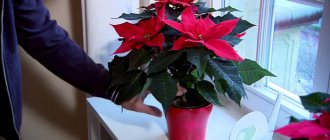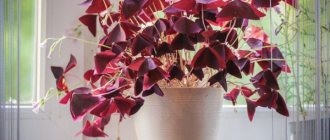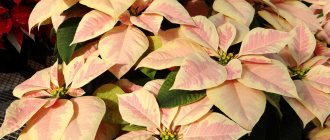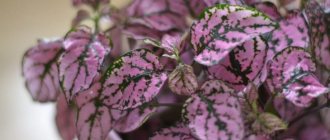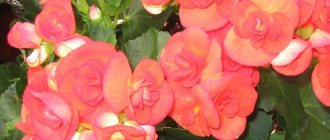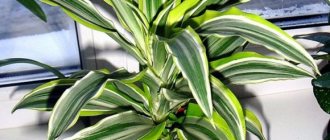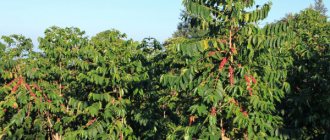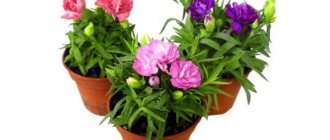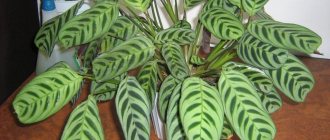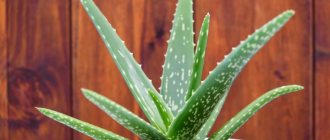The most beautiful Euphorbia (Euphorbia pulcherrima) or Poinsettia (Poinsettia), which is widely known to gardeners under the name “Christmas Star”, is one of the most beautiful indoor plants that bloom in winter.
In many countries of the Old and New Worlds, the plant is so popular that at Christmas it successfully replaces the Christmas tree and is a symbol of prosperity and comfort. There is even National Poinsettia Day, which is celebrated on December 12 in the United States.
This species belongs to the genus Euphorbia, which is part of the huge Euphorbiaceae family. The plant was named after the first United States Ambassador to Mexico, J.R. Poinsett, who first brought the plant to Washington in 1822.
The poinsettia plant is native to the temperate altitude deciduous rainforests of predominantly the Pacific coast of Guatemala and Mexico, where it is often called the flaming flower. In nature, the plant can reach up to 5 meters in height and blooms most of the year.
Description of poinsettia
In the wild, it is a shrub that reaches 3 meters in height. Belongs to the Euphorbiaceae family, their main distinguishing feature is the release of poisonous milky juice when damaged. In the past, the poisonous milk was used for medicinal purposes and to make some medicines, and the bright leaves were used for dyeing fabrics and for cosmetic purposes! This flower is an evergreen!
Poinsettia
Growing at home, this small bush, about 40 cm high, is a fluffy cap of rich green leaves, jagged at the edges. You can also find a different leaf color - two-color. In this case, the rich green leaves are yellowed towards the edges, as if dried out, but this color does not spoil the appearance at all.
At the top of the cap, yellow rosettes are formed, which are surrounded by red leaves - these are the so-called flowers!
Domestic representatives are usually one-year-old, maximum two-year-old.
The flowering period is very short, from 2 to 6 weeks, falls during the cold period of time, the Christmas holidays! By the end of flowering, the plant sheds all its leaves and becomes completely naked; from this moment it goes into a state of hibernation, but this does not mean that it has died. It is likely that by next winter it will again delight you with its enchanting beauty!
In the wild, a common poinsettia that has a bright fiery color. But time does not stand still and breeders have developed new varieties with different shades.
There are both monochromatic and variegated representatives.
Poinsettia blooming
The bright flowers of poinsettias are actually colorful leaf bracts that surround the real small, inconspicuous, odorless flowers in a bright wreath.
Blooming red poinsettia
In nature, the bracts are always red in color, and in varieties the color can be all shades of pink, white, pale green, cream, apricot, yellow and even lilac. There are two- and three-color variations, as well as varieties with stunning, seemingly terry, corrugated bracts.
Venus flytrap at home
When does poinsettia bloom? The transformation of a green plant into a colorful Christmas star only occurs under appropriate growing conditions.
To color the leaves, short sunny days and long periods of darkness of at least 12-16 hours daily are necessary, so flowering occurs in late autumn and winter. This phenomenon is called photoperiodism.
White poinsettia variety "Pure White"
Manufacturers very carefully control this process and after the required period, the most beautiful euphorbia appears in stores in all its glory, so that before Christmas everyone can decorate the house with glowing red stars.
More than one hundred million poinsettias are sold in Europe every year, and at the end of December a flower is sold every second. Flowering after purchase usually lasts 2-4 months.
After flowering, with increasing daylight hours, the most beautiful euphorbia loses its bright color of the bracts, which gradually turn green.
Varieties and varieties
Variegated
Sonora Marble
Sonora Marble
A creamy beauty with an ivory hue interspersed with a pink tint in the middle.
Winter Blush Marble
Winter Blush Marble
Surprising with the non-standard color scheme of the leaves. The crown has a soft pink color with a milky edging, surrounded by grass-colored leaves.
Strawberry and cream
Strawberry and cream
Unrealistically beautiful “marble” look. An interweaving of soft white spots with a coral tint of foliage.
Da Vinci
Da Vinci
An amazing view, striking in its beauty. Non-standard color scheme in the style of “pink flamingo”.
Monet Twilight
Monet Twilight
The owner of cream flowers with a blurred pink tint, as if stained with scarlet paint.
Tapestry
Tapestry
A chic variety, the characteristic feature of which is the heart-shaped leaves of a deep scarlet color.
Yellow and orange representatives
Lemon snow
Lemon snow
The owner of a pale lemon color.
Cinnamon star
Cinnamon star
Representatives of this variety have tiered leaf color. An amazing combination of orange color, smoothly turning into rich yellow, which turns into leaves with green veins. A distinctive feature of this species is its sharp, jagged leaves.
Orange Poincettias
Orange Poincettias
The elongated leaves of this variety have a rich orange color.
Yellow Poincettias
Yellow Poincettias
Representatives of this species have all shades of pistachio color.
Euphorbia pulcherrima
Euphorbia pulcherrima
The owner of a fiery hue. The color scheme of the leaves smoothly transitions from rich yellow to fiery orange.
Holders of white leaves
White Star
White Star
The name itself speaks for itself! Elongated, pointed leaves of pearl-beige color, collected in a bouquet, look like huge stars!
Polar Bear
Polar Bear
Representatives of this species resemble a piece of iceberg in their color. The core of the flower has a yellow tint with a slight green tint.
Arctic White
Arctic White
Cool white flowers against the backdrop of rich green leaves will not leave anyone indifferent.
All shades of red
Tapestry
Tapestry
An amazing variety that fascinates with its beauty. The flowers are a rich fiery scarlet color, and the leaves that grow along the shoot are two-colored, with a yellow coating on the edges.
Carousel Red
Carousel Red
A very unusual variety! A distinctive feature of which is the openwork edges of the inflorescence of a rich red color, which distinguishes it from the leaves themselves.
Carousel Dark Red
Carousel Dark Red
Very similar to the previous species, especially in the structure and shape of the flower, only the shade is dark scarlet.
Premium Red
Premium Red
This is a classic among all varieties. It is a lush bright red inflorescence in the middle of the crown. The core is standard - yellowish-green.
Cortez Burgundy
Cortez Burgundy
A representative of a rich burgundy shade with a traditional heart-shaped petal shape.
Other varieties
Blue poinsettia
Blue poinsettia
This view has mesmerizing beauty! The flowers are electric blue and are combined with rich green leaves, which are painted with uneven dark veins.
Eckespoint Lilo
Eckespoint Lilo
A very non-standard color scheme for poinsettias. Purple flowers with a lilac sheen.
Polly Pink
Polly Pink
The brightest representative of pink! The leaves are deep pink.
Prestige Maroon
Prestige Maroon
Queen among poinsettias! A rich, noble burgundy wine shade combined with dark emerald leaves gives this variety a regal appearance.
Description of the origin and appearance of poinsettia
Poinsettia is a magnificently beautiful flower, decorated with bracts of red, pink or cream color. The full name of the plant is the most beautiful poinsettia or the most beautiful euphorbia. The flower belongs to the Euphorbiaceae family. Like all its other representatives, poinsettia is a poisonous plant, its caustic juice causes severe irritation.
Poinsettia usually blooms in December at Christmas, which is why the flower is popularly called the Bethlehem or Christmas star.
The poinsettia became a popular Christmas flower in the early 20th century. This happened in Los Angeles in 1906. A gardener named Paul Ecke made bright and rather exotic bouquets from poinsettias that he grew in a greenhouse. The entrepreneur hoped to sell his bouquets at a higher price, so he placed the compositions on Sunset Boulevard in Hollywood (one of the most prestigious places in the city). The bright stars of poinsettias created a real sensation, and since then the flower has become an indispensable attribute of Christmas, along with spruce and Santa Claus.
Poinsettia is native to Mexico, Costa Rica and Guatemala. Under natural conditions, it is a fairly large shrub, reaching a height of 3 meters. “In captivity,” poinsettia is a small bush no more than 50 cm high. The leaf blades of the plant are dark green, elliptical in shape with teeth along the edges. The leaf size is from 10 to 15 cm in length. Poinsettia flowers are inconspicuous and small, yellowish in color and collected in rosette-shaped inflorescences.
Under natural conditions, poinsettia can grow up to 3 m in height.
Bright bracts (usually painted bright red) grow around the buds; it is for their beauty that poinsettia has become so popular among indoor plant lovers. Now experts have bred varieties whose bracts are colored in different shades of pink, yellow and white; beautiful spurge is found even with two-colored bract leaves. Poinsettia usually blooms in December at Christmas, which is why the flower is popularly called the Bethlehem or Christmas star.
Poinsettia got its name in honor of the American senator and first ambassador to Mexico, Joel Roberto Poinsett, who was not only a diplomat, but also a keen botanist. He traveled a lot in search of unknown exotic plants. Poinsett was the first to grow the flower in his greenhouse and sent it to his friends around the world.
At home, poinsettia cannot be called too capricious, although this plant requires a special approach. By creating the right conditions for a flower, you can enjoy its bright colors for many years.
By creating the right conditions for poinsettia, you can enjoy its bright colors for many years.
Poinsettia varieties
- Poinsettia with bright red bracts. The varieties of this group have bracts of a classic bright red color. Among all the variety we can highlight Prestige Maroon, Sonora, Olympia, Premium Red, Galactica and others.
- Poinsetti varieties with white bracts. Flowers with snow-white bracts or leaves in an ivory shade look very elegant. Popular varieties in this group are Christmas White, Whitestar, Sonora White and Infinity White.
- Poinsettias with bracts colored pink. The plants look very delicate. The color can be a wide variety of shades from milky pink, like the Mogen poinsettia variety, to bright pink, like the variety called Pink EII. Varieties with a salmon-colored bracts have also been bred; the Cortez Pink poinsettia looks very impressive.
- Christmas star with purple bracts. The most famous variety is Strawberry and cream. Its purple leaves have heavily cut edges, colored white.
- Variegated varieties. Poinsettias of the Da Vinci and Monet Twilight varieties look very original and impressive; their pink bracts seem to be sprinkled with white powder. A group with a marble color stands out, including the varieties Peterstar Marble and Marblestar.
- Varieties with terry effect. Winter Rose Red, Winter Rose and Winter White have unusually shaped bracts, their inflorescences resemble a rose.
- Group of poinsettias Carousel (carousel). A distinctive feature is the bracts with wavy edges. Among the varieties we can highlight Carousel Dark Red, Carousel Pink.
Variety of beautiful poinsettias: photo gallery
Poinsettias with red bracts are considered classic plants; this is the color of natural species. Breeders have bred beautiful varieties with snow-white bracts
The pink color of poinsettia leaves is mesmerizing.
Variegated poinsettias look like a bouquet of autumn leaves. Poinsettias with marbled bracts look very impressive.
The flowers of terry varieties resemble rose buds
Carousel series poinsettias resemble luxurious bushes with exotic flowers
How to choose the right flower when buying
Short daylight hours and lack of sunlight force indoor plants to remain dormant. Poinsettia, a tropical shrub, has retained the characteristic flowering characteristic of its wild relatives in the winter months, appearing in our stores in late autumn, brightening up these gloomy days with exotic splendor.
You can buy a plant only in specialized stores, where the air temperature corresponds to the conditions for keeping this particular species; it must be above 15 degrees, otherwise there is a risk of getting a flower with frostbitten roots, which will eventually become a non-viable plant.
You need to pay attention to some details:
- Lack of packaging (the flower must be clearly visible).
- The potting substrate is moderately moist (excessively wet or dry - evidence of improper care, which can affect the life cycle of the Christmas star).
- Stems - evenly colored, without black or brown spots, firmly rooted with the soil; leaves are present on all sides of the stems, bright green in color, without signs of wilting, disease, or insect damage.
- The bracts are clean, not pollinated by pollen (signs of yellowness and the presence of pollen indicate long-lasting flowering).
- The flowers should be in greenish-yellow buds (the blossoming inflorescences will soon finish flowering).
If the Christmas star corresponds to what is described, you can safely buy; if there are any discrepancies, it is better to refrain and visit another store, otherwise the purchase will turn into a tragedy. Open markets and unheated pavilions do not correspond to the maintenance of potted flowers.
Reference! Despite poinsettia belonging to the poisonous genus of euphorbia, there is no danger to domestic animals. People allergic to latex should be careful; the milky sap of the plant causes skin irritation.
Diseases, pests and possible problems with cultivation
Most problems with poinsettias are caused by improper care. The reasons for premature leaf fall and yellowing may be:
- Dry indoor air;
- Failure to comply with the watering regime;
- Excessively frequent spraying or high room humidity;
- The flower is placed in a draft, for example, cold air from a window hits it or a blow from an air conditioner hits it;
- After purchase, the flower was exposed to cold air for a long time;
- Leaves burn when exposed to direct sunlight;
- Lack of lighting during flowering and active growth.
If the edges of the leaves begin to turn yellow and brown spots appear , the owner may have been overzealous in applying fertilizers or an excessive amount of salt has entered the soil.
If the leaves of the plant are deformed holes are formed in them, you should pay attention to the soil, perhaps it has strong acidity.
The cause of leaf wilting may be excessive moisture or lack of watering. Normalizing the process will return the plant to a healthy appearance. To do this, you need to ensure that the soil does not dry out completely. Water in small portions.
You can notice the following modifications on poinsettia leaves:
- The formation of flat, slightly protruding scales above the surface. The cause of this problem is difficult to determine. These could be viral diseases, improper fertilization, or exposure to cold. When comfortable conditions are restored, the problem goes away on its own;
- The appearance of white spots on the bracts. This is explained by incorrect feeding regime and lack of normal lighting;
- Insufficient amount of molybdenum. As a result, the leaves become thinner and curl . It is necessary to spray the plant with a suitable fertilizer;
- The young leaves have a strange, different appearance from the rest. This problem is explained by a mutation. Such a change does not harm the health of the plant;
- Uneven coloring of bracts . That is, they should be bright red, and in some places green spots or veins appear. This indicates the effect of cold air on the flower. Keep the “star” warm and the problem will disappear.
Also read: Croton (Joseph's cloak): a prominent representative of the Euphorbiaceae family
Poinsettia is susceptible to the following diseases:
- Mosaic virus . The symptom is spotty changes on the leaves. The disease is caused by a viral infection carried by aphids. If the infection is severe, the flower will die;
- Root rot . This is a fungal disease that attacks the roots of the plant. The main symptom is the brown edges of the leaves; their pale color. Disease prevention is achieved through proper watering and good drainage. The plant requires replanting with soil replacement and spraying with fungicide;
- Late blight. Sign: wilting of foliage, softening of roots. The disease is caused by a fungus. Poinsettia needs to be treated with a special chemical solution;
- Stem rot. A sign is the appearance of dark spots on the stem. The flower needs to be replanted and treated with a fungicide;
- Brown rot . Mostly young plants get sick. Their shoots become thinner and acquire a brown tint. The chemical composition Rovral is used for treatment;
- Gray rot . The sign is a gray coating on the buds and surrounding leaves. The main cause of the disease is the hobby of spraying and watering in a cold room. To save the plant, you will have to remove all damaged areas and spray the flower with an antifungal compound;
- Fusarium wilt . Sign: brown or black color of the stem. The cause of the disease is a fungus. If the damage is not severe, it is necessary to cut off all damaged shoots and spray the poinsettia with Baktofit;
- Rizop rot . A dangerous disease that can destroy the entire bush. The plant appears to be covered in a moldy web. In the initial stage, spraying the ground part of the flower with burgundy liquid helps;
- Sooty mushrooms. A plaque appears on the stems and crown of the flower, which is caused by a virus. For treatment, first of all, it is necessary to rid the euphorbia of insect pests, then wash it thoroughly with a soapy solution.
If you follow the correct regime of watering, humidification and temperature in the room, a favorable environment for the appearance of fungi and other diseases will not appear.
The following insects can cause harm to poinsettia:
- Whitefly . The insects feed on the sap of the plant. The place of dislocation is the back side of the leaves. When moving, sticky marks remain on the crown and stems. The insect can be easily removed with a vacuum cleaner. It is enough to do this “cleaning” early in the morning, while the insect is sleeping. Then treat the entire bush with soapy water to remove the larvae. If there are a lot of insects, you will have to use specialized chemicals to control pests;
- Fungus gnat larvae . They settle both on the plant and in the stems. They feed on leaves and young shoots. These are small pale worms with black heads. With severe damage, the flower quickly dies. For the prevention and control of pests, it is necessary to periodically spray spurge with Aktar or similar solutions;
- Scaleworms. They live in places where leaves are attached to the stem. They feed exclusively on plant sap. During the process of life, secretions appear that look like small pieces of cotton wool. Pests are removed mechanically - with cotton wool soaked in a soap solution. Then the flower is sprayed with insecticides or a decoction of calendula or garlic;
- Aphid . It feeds on plant sap. A large generation of pests can completely destroy a poinsettia in a few days. A soap solution or special preparations help in the fight.
It is necessary to carefully inspect the plant. Then the problem with insects can be quickly solved without harm to the bush.
Do I need to move it to another pot after purchase?
There is no need to go through this procedure after purchase. But if you see that the plant is cramped in its previous pot, immediately transplant it into a new one. In places of sale, flowers are often planted in small pots to save space, so the soil is quickly depleted, and the roots lack not only space, but also nutrition.
Another important point is that in the store indoor flowers are sold in pots with transport soil. It is very light, making plants easy to transport. However, flowers do not feel very comfortable in it. This is another reason why purchased flowers need to be replanted.
Stages of flower transplantation
- Pick up a new pot. It should be 2-3 cm larger in diameter than the previous one. There is no need to take containers that are too large - water stagnates in them, which often leads to rotting of the roots.
- Select the soil mixture based on the plant variety.
- Water the plant a day before you plan to transplant it. If you can’t do it in a day, do it at least an hour in advance.
- Make a drainage layer at the bottom of the pot. You can use broken bricks or shards. Place a layer of expanded clay on top. Add sand and a 1-2 cm layer of fresh soil.
- Take the flower pot in your hands, turn it over and lightly tap it on the table, gently holding the plant. If this is problematic, separate the roots from the walls using a sharp knife.
- If there are old shards at the bottom, remove them. Leave some of the soil on the roots so as not to damage them. If some roots are rotten or damaged, cut them off.
- Place the flower on a layer of soil in a new pot, carefully fill the remaining space with fresh soil. To ensure that there are no voids left, after adding another layer of soil, tap the edge of the pot on the table. The stem should be located in the middle.
- Press the soil around the roots with your fingers. Water the plants generously and move them to a sheltered place for a couple of weeks. Spray the leaves every day. After the specified time, the flower can be placed in its original place and cared for as usual.
Bloom
The flowering of beautiful milkweed lasts from several weeks to two months, from December to February or from January to March. Inconspicuous yellow-green flowers bloom on its young shoots, framed by large and bright bracts, the color of which depends on the species and variety.
In order for the poinsettia to please the eye with its bright star flowers, it is important to provide it with proper care and create optimal conditions: temperature, watering, lighting, environmental humidity.
To stimulate flowering, you should know some secrets. It is important to inspect the bush and remove weak shoots, ensure regular watering and spraying with warm water.
To set buds, poinsettia needs a short daylight hours - it should be in the dark for at least 12-14 hours. Therefore, in the evening, the plant should be covered with a cap made of thick fabric or paper and put in a dark place.
With this regime, flower buds should appear in 2-3 weeks. However, the “covering” procedure should be continued for another 4-6 weeks until the bracts bloom.
The duration of flowering depends on care. It is important that the temperature in the room does not fall below 16 degrees. Daily moderate watering and spraying with warm water is required. During the flowering period, you cannot feed the flower.
Is poinsettia poisonous or not?
Poinsettia tissue contains poisonous white milky juice - as does all other members of the family. This juice contains euphorbic acid, euphorbine and cyanogenic compounds, which can painfully burn the skin, cause inflammation, and if it gets into the eyes, even temporarily blind a person.
Poisonous juices are found in the roots, leaves and stems.
It is also worth knowing that the flowering leaves that delight us (those that are so beautifully colored red) owe their color to dyes belonging to anthocyanins.
Poinsettia
All this sounds menacing. And so much so that some believe that the name of the plant comes from the English. the word poison, meaning "poison". But this is just complete nonsense! The name "poinsettia" comes from the Poinsett surname of a man named Joel Roberts, who brought the Star of Bethlehem from Mexico to the United States.
In practice, as it turns out, information about the strong toxic effect and toxicity of poinsettia is greatly exaggerated.
Although Star of Bethlehem may cause gastrointestinal distress, nausea, and vomiting after ingestion, in practice this occurs in less than 10% of human consumption of the plant. The discomfort is usually very mild and rare.
However, if a poinsettia flower appears in the house, it should be installed in a place inaccessible to small children, and when caring for the plant, avoid direct contact with juices that may leak, for example, when a branch is broken. But there is no need to exaggerate. A huge number of indoor plants grown in our apartments can be much more poisonous than the Star of Bethlehem.
Popular home varieties
The Euphorbiaceae family is distinguished by its diversity of plant species. The most beautiful poinsettia (Poinsettia pulcherrima or Euphorbia pulcherrima) has many varieties depending on the color of the bracts and the shape of the leaves:
Premium Red
This is a classic example of a plant that has preserved its natural nature. Bright red leaves gather at the top of the crown into stars and symbolize Christmas.
Premium Red
Cortez Burgundy
This plant was obtained through selective breeding and is dedicated to Fernand Cortes, the conqueror of Mexico. The crown of the plant turns purple during flowering.
Cortez Burgundy
Cortez Red
It has a special appeal. Green veins gradually appear on the red stipules. It looks incredibly beautiful.
Cortez red
Winter Rose
Refers to the so-called “double” poinsettias. The upper colored leaves are collected in inflorescences resembling a rose bud.
Winter rose
Premium Miro
It differs from other plants in the double coloring of its “petals.”
Premium Miro
White Star
This is a bright representative of poinsettias, painted white. Pearl-colored bracts radiate in different directions from a pale green core.
White Star
Caring for a plant requires some attention and patience. Very often, flower owners cannot obtain secondary flowering, which depends on compliance with certain nuances during care.
How to care (briefly)
- Bloom. This culture blooms on Christmas and New Year's Eve.
- Illumination. Bright but diffused light is required (windows facing east or west).
- Temperature. During active growth and development - from 18 to 25 degrees, during the flowering period - from 14 to 16 degrees, during dormancy - from 12 to 14 degrees.
- Watering. In the summer, the bushes are watered abundantly and systematically, and in the winter, the soil should be slightly moist.
- Air humidity. During the flowering period, the bushes need to be systematically moistened with lukewarm water from a sprayer.
- Fertilizer. Feed the plant in spring, summer and autumn 2 times a month with complex mineral fertilizer. When the bushes bloom, you will need a fertilizer containing a large amount of potassium.
- Trimming. Twice a year: in April the bush is shortened to 15 centimeters, and after replanting the plant is shaped.
- Rest period. In March or April for 6-7 weeks.
- Transfer. Regularly once a year at the end of the rest period.
Poinsettia or beautiful spurge: secrets of caring for a Christmas star - video
Euphorbia or poinsettia is a wonderful flower that adds bright colors to the coldest time of the year, as it begins to bloom in December and delights with its exotic beauty for 2 months. Many people consider poinsettia to be a one-time bouquet, but it can be grown “in captivity” for several years, providing the necessary conditions for growth and flowering.
- Author: Olga Isakina
I am 40 years old. I am interested in many things. Handicrafts, gardening, floriculture and cooking are just a few of my hobbies. I am constantly discovering something new and learning something interesting. I am ready to share all my knowledge with my readers. Rate this article:
- 5
- 4
- 3
- 2
- 1
(0 votes, average: 0 out of 5)
Share with your friends!
Caring for poinsettia at home
It is recommended to grow beautiful euphorbia on windows of eastern or western orientation. It should be borne in mind that such a flower reacts extremely negatively to drafts and direct sunlight. During active growth of the bush, the temperature in the room should be from 18 to 25 degrees, during the flowering period - from 14 to 16 degrees, and during dormancy - from 12 to 14 degrees.
Temperature
Exotic indoor poinsettia requires special conditions for normal growth and beautiful flowering. Taking care of her in a city apartment is quite difficult. The plant loves humidity and is very picky about temperature conditions. The ideal temperature for a Christmas flower is 12-25˚C. He does not like drafts and cold. Also has a negative attitude towards summer heat.
It is necessary to strictly ensure that poinsettia leaves do not touch the cold glass of the window in winter. And a heating radiator so that the air around it does not dry out.
Lighting
The flower does not like to be exposed to direct sunlight, preferring bright but diffused light. If poinsettia has settled in your house, then try to place it in the illuminated areas of the loggia or garden in the summer, but at the same time avoid direct sunlight on the leaves.
If this is not possible, provide her with fresh air through ventilation, but without drafts. In order for a plant to bloom for the New Year, it requires a special light regime. The flower should be exposed to light no more than 13 hours a day, so the bush should be covered with a dark bag at dusk; light should not penetrate its surface. You can put it in a dark room and put it back in its original place only in the morning.
Such actions are necessary within 2 months; the “shortened day” tactic helps the plant form inflorescence buds and bloom before the New Year. After bright bracts have appeared, you can switch to normal light mode.
Lighting for poinsettias
Watering
Poinsettia should be watered regularly in spring-summer-autumn with soft, settled water at room temperature. It is necessary that the water moistens the entire earthen lump in the pot. Drain excess water from the pan about twenty minutes after watering.
Do the next watering no earlier than the top layer of soil from the previous watering has dried out. But do not allow the soil in the pot to dry out completely - you will lose all the leaves. If you see that the leaves of your poinsettia begin to wilt between waterings, immediately water it with a small amount of water.
And then water as usual, at the appropriate time - perhaps the break between waterings was too long, or the room was too hot and dry. In summer, it is better to water the flower more often, but moderately, so that the water does not linger in the soil for a long time. During flowering, in winter, it is important to water the poinsettia with warm water, the temperature of which is a couple of degrees higher than the air temperature in the room. Otherwise, the flower may shed its beautiful leaves.
Top dressing
Feeding the Christmas star is usually done in the spring, when the plant has finished its dormant period or about a month after you transplanted it into new soil. Feed the flower once every three weeks. It is best to use granular or complex liquid fertilizers. Fertilizers should be applied until autumn.
At the beginning of autumn, when the flower is preparing to bloom, phosphorus and potassium salts should be added. It must be remembered that the Christmas star should not be fed with fertilizers during flowering and for some time after it, as well as during the dormant period of the flower.
Conditions required depending on the season - table
| Season | Lighting | Humidity | Content temperature |
| Spring Summer | Prefers bright diffused lighting on an eastern or western windowsill. In direct sunlight, poinsettia can get burned and even die. | The humidity should be quite high, so periodically mist the air around the plant. You can increase the humidity using an indoor fountain or an electric humidifier. | +20–25 ºС optimal conditions. |
| Autumn winter | A bright window facing east or west is required. There is no need to additionally illuminate the plant. | The lower the temperature, the lower the humidity should be. | +17–20 °C during flowering and +15–16 °C during the rest period. The plant does not tolerate drafts and may lose all its leaves. |
Poinsettia loves bright, indirect light.
Poinsettia in autumn
Proper care of the wonderful flower called the Christmas star in the fall is important if you want to see it bloom just in time for the merry New Year holidays.
The difficulty is that poinsettia under natural conditions begins to bloom after the time of year with the shortest daylight hours. It lasts for about two months.
The plant should be illuminated 9-10 hours a day.
At the end of September, to simulate such conditions, the pot is placed in a non-residential building, where artificial light is not turned on in the evening and in the morning. If there is no such place in the apartment, then the flower will have to be hidden under an opaque box or film from evening until morning.
During this period, the plant should be watered regularly, as soon as the soil in the pot is half dry. Once every 7-10 days the plant needs to be fed with a composition for flowering plants.
Reviews from flower growers about poinsettia
They gave us a “Christmas star” for Christmas. Such a small fluffy bright bush, bought in a store. How to care for it so that it continues to delight us with its beauty? I'm afraid that, like most store-bought potted plants, it will die.
Tashash
https://indasad.ru/forum/18-krasivotsvetuschie/200-puansettiya-kak-ukhazhivat-za-tsvetkom
Last year I bought a poinsettia. With red beautiful leaves. In the spring I took it out onto the balcony. And this is how she grew up over the summer. I would like the leaves to turn red again. I put it in the bedroom, where we hardly turn on the light. That is, it is dark for more than 12 hours a day. It’s been standing in the dark for a week now, and the leaves don’t even think of turning red, and Christmas and New Year are coming soon...
lavanda
https://cvetoforum.ru/topic1647.html
I've been rooting the poinsettia cuttings since August - they've finally taken root. And now I just can’t wean the little one off the greenhouse. The leaves become like rags. And gradually she got used to the air (she lifted the edge of the jar), and removed it for a few minutes: no way!
Laura
https://cvetoforum.ru/topic1647.html
Poinsettia in winter
In the first ten days of December, when your flower has already lived for two months with shortened daylight hours, you can stop tormenting it. Poinsettia is placed on a windowsill in a bright, warm room.
After some time, provided that you have taken proper and regular care of the amazingly beautiful Christmas star, buds and then flowers will appear on the green branches.
An indoor poinsettia flower is often given as a gift during the winter months on the occasion of a birthday or New Year. Therefore, winter is the season when the plant most often first appears in the house. Start caring for your Christmas star correctly from the first days so that you don’t have to throw it away at the end of the holidays.
Try not to open a window or window in the place where the poinsettia is located. This tropical beauty will not survive the cold. She is also afraid of drafts.
Water the plant deeply and regularly. But, make sure that liquid does not accumulate in the pan.
An important condition for proper care of the delicate and capricious Christmas star is air humidity. Spray it 2 times a day with clean warm water or install a humidifier in the room.
Continue feeding with flowering fertilizer. Has a newly purchased flower appeared in the house? Apply fertilizer no earlier than every month.
In flower shops, to maintain the presentation of plants, they are sometimes fed too intensively.
Flowering and dormancy
"Christmas Star" attracts its customers during the flowering period. Therefore, it appears in the house at the time of abundant flowering.
The owners of the plant are very upset if a “miracle” does not happen the next year. The reason is improper care of poinsettias during the period of growth and dormancy.
It is very important to properly care for the beautiful poinsettia so that it blooms, to prepare the beautiful spurge for the dormant period:
- At the end of winter, after flowering has ended, the bracts should fall off;
- The stems of the plant are trimmed. Shoots up to 15 centimeters in length are left;
- Watering is reduced. Allow the soil to dry completely. During the dormant period, watering is carried out under the condition that the leaves wilt;
- From mid-spring, the flower begins to grow actively, so it needs brighter light and abundant watering.
Poinsettia owners expect flowers to appear by the end of the calendar year. Therefore, the question often arises: “How to make beautiful spurge bloom?”
- To do this, the flower needs to be darkened for a long time, starting from the beginning of autumn;
- In the evening, the bush is covered with a black, light-blocking cloth. This “blanket” is not removed for 14-15 hours every day. In December, small buds should appear at the top of the crown;
- A flower pot is placed on the windowsill. Make sure that leaves and shoots do not touch the cold glass. In December there is a very short sunny day, so additional darkening of the poinsettia is not needed;
- When the bud is fully formed, the bracts should begin to color in the appropriate color for the variety. The plant will take on a festive look. The flowers themselves are practically invisible against the background of incredibly beautiful foliage;
It is the provision of a “short day” regime that contributes to the coloring of the leaves surrounding the flowers in red, pink and other colors.
Different plant varieties have different flowering times. Some bloom for only a few weeks, others delight with their beauty for several months. After flowering ends, a period of rest begins. It lasts 1.5-2 months. Poinsettia can shed not only its bracts, but also most of its crown. The owners of the plant are worried that it has died. This is not true, the “Christmas Star” just needs to rest.
Poinsettia in spring
With the onset of warm spring days, poinsettia ends its flowering. The bracts are falling and the leaves are starting to fall. This means that the plant is entering a dormant phase.
Trim the Christmas star flower. It is better to leave shoots only 7-10 centimeters high in the pots. Place it in a shaded area. It is desirable that during the resting phase the air temperature in the room should be within 12-15˚C.
Water infrequently. It is necessary to allow the earthen coma to dry out completely between waterings.
Such conditions for caring for poinsettia flowers must be observed for one and a half to two months.
Making poinsettia bloom again
With the arrival of spring, the Christmas star begins to fade, as evidenced by fallen bracts. The leaves fly away along with them.
Getting your poinsettia to bloom again will take some effort. First of all, it is necessary to take into account the 3 phases of the life cycle of this plant: dormancy, active vegetation and preparation for the next flowering season. During each stage, the flower will require high-quality care with strict adherence to watering, fertilizing and optimal temperature.
Poinsettia in summer
From the end of May, the indoor poinsettia flower enters the stage of active growth. At the beginning of this period, the plant can be replanted.
Caring for a flower with such a beautiful name - Christmas star - implies:
- good lighting;
- moderate watering;
- temperature range 15-25˚С;
- fertilizing with humus or universal fertilizer.
With the onset of stable heat, the plant can be taken out to the balcony (garden).
As soon as the active growth of shoots begins, you need to begin to form a bush. Cut poinsettia branches can be used for propagation by cuttings.
How to trim poinsettia: instructions with video
During the year, the Christmas star is cut twice:
- After flowering at the beginning of the dormant period, the stems are cut at a height of 15 cm from the ground.
- In the spring, after a period of dormancy, the flower will begin to grow new branches. At this time, weak shoots are removed and a bush is formed so that it is beautiful. Formative pruning should be done after transplantation.
It is important! Be sure to prune the flower after flowering before the dormant period, since poinsettia blooms only on the shoots of the last year.
Propagation of poinsettia by cuttings
Most often, flower growers use the possibility of vegetative propagation. Best of all, cuttings 10 to 15 cm long, obtained after trimming the poinsettia, take root at home in spring and early summer.
Since the plant secretes milky sap, which interferes not only with the drying of the cut, but also with root formation, before planting pieces of stems in the ground:
- their lower leaves are cut off;
- The cut sites are immersed in water for several minutes;
- then blot with a paper napkin;
- The tips of the stems are sprinkled with a root formation stimulator.
Now the cuttings intended for poinsettia propagation are ready for planting. As a substrate, you can use a light, breathable mixture of washed sand and perlite. The root system of young plants is not too large, so first and before transplanting the poinsettia to a permanent place of residence, you can use very small pots or cups with a capacity of up to 250 ml.
A drainage hole is made at the bottom of the container. The cuttings are immersed in the soil to a depth of 3 cm, this is enough. The seedlings are placed in an indoor greenhouse.
Propagation of poinsettia by cuttings
Next, young poinsettias need:
- watering as needed;
- bright, but not direct light;
- constant temperature within 16–22 °C;
- regular ventilation.
This care is enough for the tops of the stems to sprout roots in 45–60 days and be ready to be transferred to permanent pots. To transplant poinsettias, take containers with a diameter of 7–10 cm, at the bottom of which a layer of drainage is made, and then filled with a substrate based on leaf and turf soil with the inclusion of a small amount of peat, cleared of foreign inclusions, and sand.
With the beginning of active growth, the top of the seedling is removed. This type of pruning of poinsettia at home allows you to immediately get a branching bush with several bright inflorescences.
Poinsettias that have already bloomed in the previous season are replanted in a similar manner. The procedure is carried out in the second half of spring after pruning the houseplant.
Reproduction
In the wild, reproduction is carried out by seeds. The ornamental plant does not produce full seeds, so it is propagated by cuttings. The most successful period for reproduction is summer.
- A cutting of at least 10 centimeters in length is cut from the top of the bush. It should have about 5 internodes. Place the cuttings in a container of warm water for a few minutes;
- Juice begins to appear abundantly on the cut. It must be sprinkled with charcoal powder. The cut itself is dried with a paper towel. Do not forget that the sap of the plant is poisonous, so all manipulations are performed with protective gloves;
- To plant cuttings, use small containers filled with sand and peat substrate;
- The cutting goes 2-3 centimeters into the soil. You can organize a greenhouse. The main thing is that the soil is always slightly moist and the air temperature does not fall below 22 degrees. To speed up the process, you can use stimulants - heteroauxin or root. Under such conditions, the first roots will appear in 15-20 days.
Now you can begin to form a bush. To do this, the shoot is pinched at the height of the 6th leaf. The procedure is repeated constantly to give the plant maximum bushiness. No additional transplant will be needed. After rooting, poinsettia does not immediately acquire its original decorative effect. This will take at least 12 months. It is necessary to ensure that the room is warm. If the temperature drops below 16 degrees for a long time, the young shoot may die.
- 3-4 months after rooting, the cuttings are transplanted into a pot filled with soil for an adult flower.
Also read: Myrtle - a tree of peace and love on your window
Poinsettia propagation by seeds
Few people know that pruning is not so necessary to propagate poinsettia at home. By pollinating the tiny flowers yourself, you can wait until round, almost black seeds form and ripen.
It is more convenient to transfer pollen using a cotton swab or a thin soft brush. At the same time, it is important to touch each flower and make sure that the grains get where they need to be.
Poinsettia propagation by seeds
After some time, greenish seed pods appear in place of the flowers, resembling small bulbs in appearance.
When the foliage begins to fall, the boxes are collected and stored in a paper bag without access to moisture. The dried, brown boxes open easily, and the ripened seeds roll out.
To encourage the formation of sprouts, poinsettia seeds, laid out on moist soil and lightly sprinkled with soil, are placed in a household refrigerator for three months for stratification.
Germination begins in warm conditions and takes several weeks. All this time, the crops should be moderately moistened. Mold or rot should not be allowed to appear, so the greenhouse must be ventilated regularly.
Caring for seedlings is not much different from other domestic crops. Small plants are first picked, and then, when they become stronger, the poinsettias are transplanted into spacious pots.
Growing poinsettia
As a rule, beautiful euphorbia is purchased in the store during flowering and presented as a gift for Christmas. Most often, when the bush fades, it dies, but if it is provided with proper care, such a plant will become a perennial, and it will decorate your home every time at Christmas. Tips for growing poinsettias:
- After the foliage begins to fly around, it is necessary to reduce watering of this plant, and the substrate should be almost dry. You also need to stop adding fertilizer to the soil mixture and shorten the shoots to 15 centimeters from the ground level. Then the container with the flower is placed in a cool and dark place, where it should remain until May.
- With the onset of May, the poinsettia will need to be stimulated to begin growing, and it should be placed in a sunny place. Then you should start watering and fertilizing with mineral fertilizers. After the bush begins to grow, it will need to be replanted into a fresh substrate.
- In the first days of October, plants need to be put away at night in a box that does not allow light to pass through. Or the pot can be placed in a closet, and it must be there for at least 14 hours a day. This helps stimulate the formation of buds on the bush.
- From the beginning of the opening of the bracts, the bushes need to be provided with regular care.
When growing beautiful milkweed, you should remember that the milky juice that it secretes is poisonous. The juice can cause the most serious harm to the eyes if it gets into them. There have been cases when the juice of this plant caused an allergic reaction. If it gets into the gastrointestinal tract, it will cause vomiting and intestinal upset. In this regard, it is necessary to wear protective gloves when working with flowers.
All members of the Euphorbia family are poisonous. However, caring for such plants varies greatly depending on the species.
Diseases and pests
Leaves and inflorescences may begin to lose color, fade, and fall off. This means that you have over-moistened the soil, or placed the pot with the plant in a draft, or the plant does not have enough lighting.
If the leaves turn brown and the flowers fall off, the flower is too hot and dry.
Most often, poinsettia suffers from attacks by thrips, spider mites and mealybugs.
If there are wavy oblong spots on the leaves, or the leaves begin to curl, then these are thrips.
The scale insects cause the leaves to become covered with honeydew (a sticky, drop-like secretion).
If the leaves begin to rapidly turn yellow and dry out, this is a spider mite.
Wipe the plant with soapy water and rinse under a warm shower (but do not over-wet the soil). Treat with pest repellents.
What to do if it doesn’t bloom, how to make it turn red?
The red leaves of the poinsettia surround its flowers and fall off or turn green after blooming. As a result, if the plant does not bloom, there will be no bright “stars” on it. This could be caused by improper lighting:
- lack of light;
- lack of day and night mode;
- daylight hours are too short.
Some time after the problem is eliminated, the flower will again delight you with flowering and a red crown. Also, problems with flowering can arise due to improper care. This is usually accompanied by a deterioration in the appearance of the plant: lethargy, dryness.
The magical properties of poinsettia
How Poinsettia affects people:
- helps revive marital love, makes relationships passionate and bright;
- helps to replenish the family: it is recommended to keep it for spouses who are unable to have a child;
- gives pure energy of joy, helps drive away depression, despondency and blues, it has the power to maintain a good mood, create a warm atmosphere, attract new opportunities for positive emotions;
- improves the well-being of the inhabitants of the house, increases enthusiasm and vitality (it will help a sick person to recover faster);
- attracts well-being and prosperity - in the spiritual and material aspects;
- helps to assimilate knowledge, concentrate, think creatively and generate new ideas - a person thinks faster, is less tired of intellectual work, works efficiently and with pleasure.
In addition, the flower protects from negative energy: the evil eye, damage, external bad influence, internal conflicts and fears. Only pleasant and friendly people come to the house where poinsettia grows, but those who are hostile here become uncomfortable. The atmosphere in the family becomes warm and friendly, and the financial situation stabilizes.
Is it possible to keep the plant at home?
Poinsettia has the unique ability to clean up its territory, eliminating negativity and bringing joy. As a symbol of happiness, it makes family members more sociable and friendly.
It is important where the Christmas star will be placed. She loves groups, preferring common rooms. Bright, spacious rooms are most optimal.
In this case, you need to take into account the natural needs of the flower. The extremely capricious poinsettia requires good care. Bad conditions steal its healing power.
- If the owners of the flower are newlyweds, the bedroom is the optimal place. Poinsettia will help strengthen relationships. This will make the marriage happy and carefree.
- In a large family, the living room or kitchen is most suitable for a flower. There the plant will be able to distribute energy evenly.
- Poinsettia has a positive effect on children, increasing their academic performance and revealing the children’s abilities and talents. However, the flower is not suitable for children's rooms; it stimulates the central nervous system and can cause sleep disturbances.
Benefits of the flower
- Harmonizes space, creates a positive atmosphere in the house.
- Helps normalize weight.
- Stimulates brain function, helps with learning and creativity.
- Provides aesthetic pleasure and peace of mind.
- Treats skin diseases, fever, cough.
- Helps relieve toothache.
- Improves the patient's condition with rheumatism and neuritis.
- Suppresses the development of streptococci and Escherichia coli.
How can it be dangerous?
Unpleasant sensations may arise from contact with plant juice:
- Signs of skin and mucous membrane irritation.
- Manifestation of allergic reactions, especially in young children.
- Diarrhea or vomiting when ingesting leaves or stems.
Otherwise, the plant has no negative properties; on the contrary, positive signs dominate:
- Eliminates negative energy.
- Strengthens the relationship between spouses.
- Improves mood.
- Activates the brain.
- Helps promote business and increase productivity.
- Improves metabolism.
- Reveals hidden talents and capabilities.
- Reveals damage and the evil eye.
- Has healing powers.
- Helps childless families have a child.
- Helps to lose excess weight.
Poinsettia: signs and superstitions
Blooming luxuriantly at Christmas, poinsettia has healing powers and brings good luck. It should be placed in the center of the Christmas table - then those present will be healthy, joyful and rich all year long.
Natural poinsettia has bright red bracts - it attracts well-being, prosperity, good mood and pleasant guests to the house, and helps children study better. Today, breeders are developing varieties of a wide variety of colors and shades. The palette also affects the energy: soft pink, peach and creamy yellow varieties have less pronounced fire energy, and blue and purple varieties have an element of the water element.
Poinsettia Sonora White glitter
Other beliefs:
- If a cat gets into the habit of eating this flower, it is in the wrong place. Judging by the sign, another part of the house needs his positive influence - rearrange the flowerpot until the animal loses interest in it. But at the same time, follow the rules of maintenance - plenty of light and no drafts.
- Leaves on the plant suddenly fall off - this means that one of the family members is ill. This is often due to lack of care - eliminate mistakes and take care of the flower correctly. While recovering, he will restore favorable energy. However, if abscission occurs naturally (after flowering on the eve of the dormant period), this superstition is not relevant.
- If, during pruning, milky juice splashes directly into the face, the omen speaks of a dangerous ill-wisher. He spreads bad rumors, weaves intrigues and tries to harm you. Use cut cuttings to propagate the plant - this way you will strengthen protection and improve the quality of life, despite the machinations of enemies.
- A gift of poinsettia strengthens relationships between people, making them joyful, selfless, loving and faithful.
Euphorbia sheds its lower leaves: what to do after this?
After flowering, the bracts turn green, then turn pale and fall off. The plant loses its decorative effect. The poinsettia then sheds its lower leaves, exposing the trunk. Some inexperienced gardeners decide that the plant is dead and get rid of it. In fact, poinsettias require pruning and rest before they will resume growth and be ready to bloom again.
We talked about what to do if the poinsettia gets sick and sheds its leaves in December, as well as about various diseases and pests of the plant in our material.
Poinsettia can be induced to bloom by creating a regime of short daylight and long night. With proper care, the Christmas star will delight you with its bright leaves on New Year's Eve, creating coziness and a festive atmosphere in the room.
Feng Shui
Poinsettia in the interior
Bright red poinsettia activates fiery energy and speeds up all processes. It can be kept in your personal account to generate new ideas, increase income, and improve communication skills. In the marital bedroom, she will add passion to intimate relationships. In the kitchen or dining room, a flower will bring special benefits: it will make family feasts fun and enjoyable, attract prosperity, improve the taste and energy of food, increase metabolism in the body and help lose weight.
Feng Shui masters say that the living room is a universal place for poinsettias. Here it performs the main functions: creates a favorable atmosphere, establishes mutual understanding between family members, and produces the energy of joy.
If there is already too much “fire” in your house (bustle, guests, excitement, rush, constantly changing events, etc.) - opt for a decorative variety with a different shade of bracts: pink, peach, creamy yellow, orange.
If you strive for spiritual growth, get a purple variety, and if you want clarity of thinking and serenity, get a blue one.
Feng Shui meaning
Poinsettia will become a real talisman for the home, which will protect your family and actively nourish it with energy. Feng Shui recommends placing the flower separately from other plants.
A bedside table will do, and if there is not enough lighting in the room, a window sill. However, it is not recommended to always keep poinsettia in the bedroom. But not because the flower can cause a lot of harm. It’s just that so much life-giving energy emanates from it that you won’t always be able to sleep peacefully.
Is it possible to keep poinsettia at home?
This is a very beautiful flower with gorgeous blooms and great energy. You can and should keep it at home, but you need to remember some features. This plant belongs to the euphorbia species, the milky juice of which is poisonous (although in this case less so than that of other varieties). If it gets into the stomach, it can cause poisoning, irritation on the skin, and burns on the mucous membrane.
Therefore, you should not have it in a house where there are small children, and as for pets, they have a good sense of smell and avoid dangerous vegetation. Some cats still eat poinsettia and, judging by the reviews of their owners, without visible harm. However, it is better to place the flowerpot away from those who want to chew the leaves. Even if the cats are not harmed, the damaged plant may refuse to bloom.
It is better to carry out pruning, replanting and cuttings with gloves and careful attention so that the juice does not splash into your eyes (to be on the safe side, you can wear safety glasses). Energy and care Only a healthy and flowering plant has positive energy.
In poor conditions and without proper care, it will begin to broadcast not benign “emotions”. Therefore, it is worth starting it only in those houses where it will be properly looked after.
There are a few important rules to remember:
- Do not overwater the flower - like all euphorbias, it does not tolerate waterlogging;
- To keep the bracts bright, fertilize them with a special composition;
- After flowering, when the leaves fall, prepare the plant for the dormant period: cut the stems, stop feeding and reduce watering;
- Starting from October, organize a “short day” regime for two months: at about 17-00, cover the flower with a dark bag and transfer it to the closet, and early in the morning put it on the windowsill - this will stimulate the formation of buds and beautiful “stars” will appear just in time for the winter holidays.
Sources and literature
Sources and literature
- Bernardino de Sahagun, Kuprienko S.A. General history of the affairs of New Spain. Books X-XI: Knowledge of the Astecs in medicine and botany / Ed. and lane S. A. Kuprienko.. - K.: Vidavets Kuprienko S. A., 2013. - 218 p.
- Beketov A. N. Dicotyledons // Encyclopedic Dictionary of Brockhaus and Efron: in 86 volumes (82 volumes and 4 additional). - St. Petersburg, 1890-1907.
- Paul E.Ranch “The Poinsettia and its legend”, Chicago, 2001
- Klug, S., Saleem, G., Hocharuk, L., Marcus, S. Toxicity potential of poinsettia, is the plant really toxic? Ottawa, 1990.
- Taylor, Judith M.; Lopez, Roberto G.; Currey, Christopher J.; Jan, Jules. The Poinsettia: History and Transformation // Chronica Horticulturae. - 2011. - T. 51, No. 3. - P. 23-27.
Features of development
For a plant such as poinsettia, a period of rest is necessary, since at this time it rests and gains strength before the next flowering. The rest period should not be long - only 2 months. It begins from the moment the plant completely fades. To organize a dormant period, it is necessary to reduce the temperature to 12-14ºС and reduce watering.
Poinsettia is a flower whose decorative shape needs to be created by pruning.
Poinsettias are pruned in the spring after flowering has ended . All shoots of the plant are shortened by a third, and at least 4 buds should remain on each.
This will ensure good branching and abundant flowering. After all, an inflorescence appears on every shoot in winter.
Poinsettia will feel comfortable in any room of the apartment. The main conditions are that the place be well lit and warm.
Since the plant prefers bright, but at the same time diffused lighting, it is optimal to choose western or eastern windows for it. The flower is thermophilic, so the temperature in the room should not fall below 16 degrees.
The beautiful spurge is very afraid of drafts and temperature changes , so when ventilating the premises, the pot with it should be removed away from the windows.
Poinsettia is perfect for decorating a hall, living room, bedroom or holiday table in the kitchen. It can be used in a nursery if the child does not have an individual intolerance to the plant’s white juice. Otherwise, upon contact with it, dermatitis may occur.
